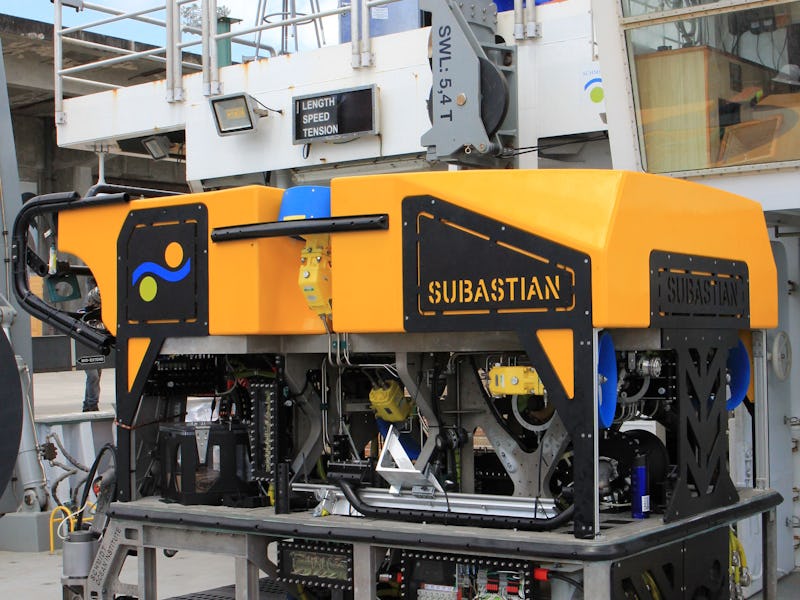In the Trenches With the Undersea Drone SuBastian
SuBastian will transmit data about parts of the ocean floor we know virtually nothing about.

This spring, the Schmidt Ocean Institute in Palo Alto developed a robot that’s capable of exploring the ocean floor for weeks at a time without surfacing. The deep-diving ROV is remarkable precisely because it doesn’t need to surface — it’s charged and controlled remotely — so it can explore the environment 15,000 feet down at length. That’s a big deal for both scientists and SuBastian, as the undersea drone is affectionately known. Little is understood about that part of the ocean, specifically in the Pacific environs where it will be tested.
SuBastian and the small army of engineers and auxiliary equipment that accompanies it have just arrived in Guam, where it’s being prepped to begin its mission. It’ll be roving the ocean floor for a month, gathering with a 4K camera lens and high-quality sonar. Toward the end of this year, it will be moved to the Mariana’s Trench, the deepest point in the ocean and this a point of great scientific interest and value. It feels almost inevitable that SuBastian will see things humans have not.
Carlie Wiener, of the Schmidt Ocean Institute, spoke to Inverse about the day-to-day operations in Guam and what it’s like aboard the “little city” that keeps SuBastian running.
You’ve been out there a few days now — have you gotten SuBastian settled in?
The first couple of days were about mobilization, so just getting everything on the ship. SuBastian is 6,500 lbs, it’s not something you can lift easily — it required a crane to get her on. And we had a container van, an electrical van helping connect the ship to the ROV and getting all the supplies on board. And integrating the docking head, an instrument we designed for the ship. That’s what’s going to deploy and pick up SuBastian, so that had to get added and aligned properly. It’s amazing to watch the team troubleshoot everything.
It’s a little calmer now. We just finished the science control room. [Now] we’re planning on integrating the actual controls for the vehicle into the control room. They look like video game controllers, so there’s a very specific plan of milestones and things we want to accomplish each day. Some of the vendors are [about to come] out to do final checks. On July 19th we leave the dock and head out to sea until August 16th to drop her in the ocean.
We’ll drop her in starting shallow and pull her back up, go a little deeper, pull her back up. It’s a phased approach. But she’s a really good-looking vehicle, with all these lights and cameras, and the manipulator moves really smoothly.
ROV SuBastian is loaded onto the back deck of R/V Falkor.
Now that you’re in more of a routine, how does your morning begin?
Every day is a little bit different. We’re ahead of schedule, which is great. I would have just assumed you plop the robot on the boat and you’re good to go, but you have to integrate the system, deal with all the electricity, change the winch, make sure the ship can talk to the vehicle and vice versa. There are so many different pieces. It’s like this little city here, there’s always things going on, always things happening no matter the time of day.
We usually have breakfast at 7 and a meeting at 7:30 with the entire ROV team to talk about the plan for the day. At 8 we meet with the crew and captain and technicians and update them, just touching base. Plans change depending on how things go, a series of tests from day to day. We’re also in Guam, where it’s a million degrees out and it’s super humid. The guys are such troopers.
The ROV engineering team.
This is so open-ended because we know so little about the ocean floor — is there anything in particular you’re excited about or hoping to find?
Every year we open a call for expressions of interest. Scientists from around the world can apply for ship time, and we’re really focusing on high-risk, high-reward, cutting-edge science that wouldn’t normally get funded by traditional funding agencies. We still don’t know a lot about the deep ocean. We just discovered hydrothermal vents in the ’70s. Last December, in the Mariana Back-Arc, we had a cruise where we discovered three brand-new hydrothermal vents, and one’s in the top three deepest vents in the world. We want to go back with SuBastian and get a better look at these ecosystems, be able to collect samples and video record, and just better understand these ecosystems. We’re pretty much making new discoveries every time.
This interview has been edited for brevity and clarity.